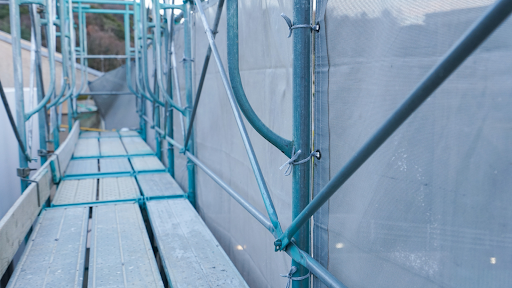What Is Scaffold Mesh and How Is It Used on Construction Sites?
Scaffold mesh is a woven polyethylene material designed to wrap around temporary scaffolding structures and perimeter fencing. This durable scaffolding mesh creates a protective barrier that contains dust particles and prevents construction debris from escaping the work zone.
Australian construction sites deploy scaffold netting across multiple applications:
- Dust containment during demolition and renovation work
- Debris prevention to protect pedestrians and adjacent properties
- Site mesh barriers for perimeter security and visual screening
- Mesh fencing around multi-storey scaffolding structures
The lightweight yet robust nature of the site mesh makes it ideal for wrapping around steel scaffolding frames, where it secures with cable ties or bungee cords. This versatile material integrates seamlessly with other construction safety elements, creating comprehensive protection throughout the building process.
How Does Scaffold Mesh Help Control Dust on Construction Sites?
Scaffold mesh acts as a physical barrier that traps airborne particles before they escape the work zone. The fine weave structure captures dust emissions at the source, preventing hazardous silica and concrete particles from spreading to neighbouring properties or affecting workers in adjacent areas.
Scaffold mesh fencing dust control delivers measurable improvements in air quality by:
- Creating a semi-permeable screen that filters particulates whilst maintaining ventilation
- Reducing respirable dust exposure by up to 70% when properly installed around cutting, grinding, and demolition activities
- Minimising complaints from nearby residents and businesses about dust pollution
The material plays a vital role in dust emissions reduction compliance under Australian workplace health and safety regulations. Sites using scaffold netting demonstrate cleaner conditions during inspections, avoiding costly work stoppages and potential fines. When combined with water suppression systems, scaffold mesh provides comprehensive construction site safety by addressing both immediate worker health concerns and long-term environmental impact.
How Does Scaffold Mesh Provide Wind Protection for Scaffolding?
Scaffold mesh wind protection reduces wind speed by about 30-50% while allowing air to flow through the structure. The perforated design of scaffold shade cloth and scaffold netting creates a barrier that spreads out wind pressure instead of completely blocking it, preventing the dangerous build-up of force that solid barriers would cause.
Wind-induced scaffold movement poses serious risks on exposed construction sites, particularly in coastal Australian locations where gusts exceed 60 km/h. Properly installed mesh fencing anchors the structure by distributing wind loads evenly across the framework, preventing the sideways movement or catastrophic collapse that can happen with unprotected scaffolding.
Scaffolding stability improves significantly when mesh coverage extends from ground level to the top platform. The material acts as a semi-permeable shield that:
- Reduces wind pressure on workers and materials by up to 40%
- Prevents tools and debris from becoming airborne projectiles
- Maintains structural integrity during unpredictable weather conditions
High-rise projects benefit most from UV-resistant scaffold netting, which keeps its wind-dampening properties throughout long construction periods without deteriorating under constant sun exposure.
What are the benefits of using scaffold mesh for worker safety?
Scaffold mesh safety barrier systems create a protective envelope around work zones that actively prevent tools, materials, and debris from falling beyond the construction perimeter. This containment is critical on multi-storey projects where even small objects can cause serious injuries when dropped from height.
The worker protection extends to both on-site personnel and pedestrians passing near construction zones. Scaffold mesh acts as a first line of defence against falling object prevention, catching loose materials before they can reach ground level. When installed correctly, the mesh creates overlapping layers of protection that work alongside structural elements like reo bars and formwork plywood to establish comprehensive site safety protocols.
Site managers appreciate how scaffold mesh seamlessly integrates with existing safety infrastructure, eliminating the need for significant modifications to scaffolding systems or work platforms.
How to choose the right scaffold mesh for dust and wind control?
Selecting the right scaffold mesh depends on your site’s specific dust and wind exposure levels. High-exposure sites require denser scaffolding mesh (90% coverage), while moderate conditions work well with 50% coverage scaffold shade cloth that maintains airflow.
Durability matters for temporary scaffolding projects. UV-resistant scaffold netting prevents degradation under the Australian sun, extending the lifespan of your site mesh investment. Look for materials rated for outdoor use with reinforced edges to withstand repeated installation.
The ideal mesh fencing balances containment with ventilation. Dense weaves control dust effectively but increase wind load on scaffolding structures. Lighter site mesh allows better airflow, reducing structural stress whilst still capturing larger debris. Match your mesh density to both environmental conditions and scaffold load capacity for optimal safety and performance.

